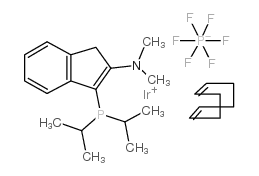3-DI-I-PROPYLPHOSPHINO-2-(N,N-DIMETHYLAMINO)-1H-INDENE(1,5-CYCLOOCTADIENE)IRIDIUM(I) HEXAFLUOROPHOSPHATE
Modify Date: 2024-01-04 18:45:37

3-DI-I-PROPYLPHOSPHINO-2-(N,N-DIMETHYLAMINO)-1H-INDENE(1,5-CYCLOOCTADIENE)IRIDIUM(I) HEXAFLUOROPHOSPHATE structure
|
Common Name | 3-DI-I-PROPYLPHOSPHINO-2-(N,N-DIMETHYLAMINO)-1H-INDENE(1,5-CYCLOOCTADIENE)IRIDIUM(I) HEXAFLUOROPHOSPHATE | ||
|---|---|---|---|---|
| CAS Number | 870077-94-4 | Molecular Weight | 720.73100 | |
| Density | N/A | Boiling Point | N/A | |
| Molecular Formula | C25H38F6IrNP2 | Melting Point | N/A | |
| MSDS | N/A | Flash Point | N/A | |
| Name | (1Z,5Z)-cycloocta-1,5-diene,3-di(propan-2-yl)phosphanyl-N,N-dimethyl-1H-inden-2-amine,iridium,hexafluorophosphate |
|---|
| Molecular Formula | C25H38F6IrNP2 |
|---|---|
| Molecular Weight | 720.73100 |
| Exact Mass | 721.20100 |
| PSA | 30.42000 |
| LogP | 10.82680 |
|
Section 1: Product Identification 3-Di-i-propylphosphino-2-(N,N-dimethylamino)-1H-indene(1,5-cyclooctadiene)iridium(I) hexafluorophosphate, Chemical Name: min. 98% CAS Registry Number:870077-94-4 Formula:C25H38F6IrNP2 EINECS Number:none
Chemical Family:metal organo complex Synonym:(3-Diisopropylphosphanyl-1H-inden-2-yl)-dimethyl-amino(1,5-cyclooctadiene)iridium(I) hexafluorophosphate Section 2: Composition and Information on Ingredients IngredientCAS NumberPercentACGIH (TWA)OSHA (PEL) Title compound870077-94-4100%2.5mg/m3(as F)2.5mg/m3(as F) Section 3: Hazards Identification Emergency Overview:Irritating to skin, eyes and respiratory tract. Primary Routes of Exposure:Inhalation, skin, eyes Eye Contact:Causes slight to mild irritation of the eyes. Skin Contact:Causes irritation to the skin Inhalation:Causes irritation to the nose, mucous membranes and respiratory tract Ingestion:No information on the physiological effects of ingestion. May be harmful if swallowed. Acute Health Affects:Irritating to skin, eyes and respiratory tract. Product contains fluorine which, under certain conditions of use, decomposition or metabolism, may generate Chronic Health Affects:fluoride ion causing nausea, vomiting, labored breathing, hypocalcaemia, deterioration of bone and tooth structure and kidney and liver damage. NTP:No IARC:No OSHA:No SECTION 4: First Aid Measures Immediately flush the eyes with copious amounts of water for at least 10-15 minutes. A victim may need Eye Exposure: assistance in keeping their eye lids open. Get immediate medical attention. Wash the affected area with water. Remove contaminated clothes if necessary. Seek medical assistance if Skin Exposure: irritation persists. Remove the victim to fresh air. Closely monitor the victim for signs of respiratory problems, such as difficulty Inhalation: in breathing, coughing, wheezing, or pain. In such cases seek immediate medical assistance. Seek medical attention immediately. Keep the victim calm. Give the victim water (only if conscious). Induce Ingestion: vomiting only if directed by medical personnel. SECTION 5: Fire Fighting Measures Flash Point:no data Autoignition Temperature:no data Explosion Limits:no data Extinguishing Medium:carbon dioxide, dry chemical or foam If this product is involved in a fire, fire fighters should be equipped with a NIOSH approved positive pressure Special Fire Fighting Procedures: self-contained breathing apparatus and full protective clothing. Hazardous Combustion andIf involved in a fire, this material may emit irritating organic fumes Decomposion Products: Unusual Fire or Explosion Hazards: No unusual fire or explosion hazards SECTION 6: Accidental Release Measures Small spills can be mixed with vermiculite, sodium carbonate or other suitable non-combustible adsorbent and Spill and Leak Procedures: swept up. SECTION 7: Handling and Storage Handling and Storage:Store in a tightly sealed container in a cool, dry place. SECTION 8: Exposure Controls and Personal Protection Eye Protection:Always wear approved safety glasses when handling a chemical substance in the laboratory. Skin Protection:Wear protective clothing and gloves. Ventilation:Handle the material in an efficient fume hood. If ventilation is not available a respirator should be worn. The use of respirators requires a Respirator Respirator: Protection Program to be in compliance with 29 CFR 1910.134. Ventilation:Handle the material in an efficient fume hood. Additional Protection:No additional protection required. SECTION 9: Physical and Chemical Properties Color and Form:orange powder Molecular Weight:720.73 Melting Point:no data Boiling Point:no data Vapor Pressure:no data Specific Gravity:no data Odor:not determined Solubility in Water:insoluble SECTION 10: Stability and Reactivity Stability:air and moisture stable Hazardous Polymerization:no hazardous polymerization Conditions to Avoid:none Incompatibility:oxidizing agents and halogens Decomposition Products:carbon monoxide, carbon dioxide, organic fumes, fluorinated by-products and iridium compounds SECTION 11: Toxicological Information RTECS Data:No information available in the RTECS files Carcinogenic Effects:no data Mutagenic Effects:no data Tetratogenic Effects:no data SECTION 12: Ecological Information Ecological Information:No information available SECTION 13: Disposal Considerations Disposal:Dispose of according to local, state and federal regulations SECTION 14: Transportation Shipping Name (CFR):Non-hazardous Hazard Class (CFR):NA Additional Hazard Class (CFR):NA Packaging Group (CFR):NA UN ID Number (CFR):NA Shipping Name (IATA):Non-hazardous Hazard Class (IATA):NA Additional Hazard Class (IATA):NA Packaging Group (IATA):NA UN ID Number (IATA):NA SECTION 15: Regulatory Information TSCA:Not listed in the TSCA inventory SARA (Title 313):Title compound not listed Second Ingredient:none SECTION 16 - ADDITIONAL INFORMATION N/A |